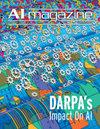Comparison of Various Nitrogen and Water Dual Stress Effects for Predicting Relative Water Content and Nitrogen Content in Maize Plants through Hyperspectral Imaging
IF 2.5
4区 计算机科学
Q3 COMPUTER SCIENCE, ARTIFICIAL INTELLIGENCE
引用次数: 0
Abstract
Water and nitrogen (N) are major factors in plant growth and agricultural production. However, these are often confounded and produce overlapping symptoms of plant stress. The objective of this study is to verify whether the different levels of N treatment influence water status prediction and vice versa with hyperspectral modeling. We cultivated 108 maize plants in a greenhouse under three-level N treatments in combination with three-level water treatments. Hyperspectral images were collected from those plants, then Relative Water Content (RWC), as well as N content, was measured as ground truth. A Partial Least Squares (PLS) regression analysis was used to build prediction models for RWC and N content. Then, their accuracy and robustness were compared according to the different N treatment datasets and different water treatment datasets, respectively. The results demonstrated that the PLS prediction for RWC using hyperspectral data was impacted by N stress difference (Ratio of Performance to Deviation; RPD from 0.87 to 2.27). Furthermore, the dataset with water and N dual stresses improved model accuracy and robustness (RPD from 1.69 to 2.64). Conversely, the PLS prediction for N content was found to be robust against water stress difference (RPD from 2.33 to 3.06). In conclusion, we suggest that water and N dual treatments can be helpful in building models with wide applicability and high accuracy for evaluating plant water status such as RWC.利用高光谱成像技术预测玉米植株相对水分和氮含量的氮水双重胁迫效应比较
水和氮是植物生长和农业生产的主要因子。然而,这些往往是混淆的,并产生重叠的植物胁迫症状。本研究的目的是通过高光谱模型验证不同水平的N处理是否影响水状态预测,反之亦然。以108株玉米为研究对象,在3级氮配3级水处理下进行温室栽培。采集这些植物的高光谱图像,然后测量相对含水量(RWC)和N含量作为地面真值。采用偏最小二乘(PLS)回归分析建立了RWC和N含量的预测模型。然后,分别针对不同的N处理数据集和不同的水处理数据集,比较其准确性和稳健性。结果表明,利用高光谱数据对RWC的PLS预测受到N应力差(性能偏差比;RPD从0.87到2.27)。此外,水氮双应力数据集提高了模型的精度和鲁棒性(RPD从1.69提高到2.64)。相反,PLS对氮含量的预测对水分胁迫差异(RPD从2.33到3.06)是稳健的。综上所述,水氮双重处理有助于建立适用范围广、精度高的植物水分状态(如RWC)评价模型。
本文章由计算机程序翻译,如有差异,请以英文原文为准。
求助全文
约1分钟内获得全文
求助全文
来源期刊

Ai Magazine
工程技术-计算机:人工智能
CiteScore
3.90
自引率
11.10%
发文量
61
审稿时长
>12 weeks
期刊介绍:
AI Magazine publishes original articles that are reasonably self-contained and aimed at a broad spectrum of the AI community. Technical content should be kept to a minimum. In general, the magazine does not publish articles that have been published elsewhere in whole or in part. The magazine welcomes the contribution of articles on the theory and practice of AI as well as general survey articles, tutorial articles on timely topics, conference or symposia or workshop reports, and timely columns on topics of interest to AI scientists.
 求助内容:
求助内容: 应助结果提醒方式:
应助结果提醒方式:


